THALES DIS AlS Deutschland MC75 Quadband GSM/GPRS/EGPRS Module User Manual MC75
Gemalto M2M GmbH Quadband GSM/GPRS/EGPRS Module MC75
Contents
- 1. Users Manual Part 1
- 2. Users Manual Part 2
Users Manual Part 2
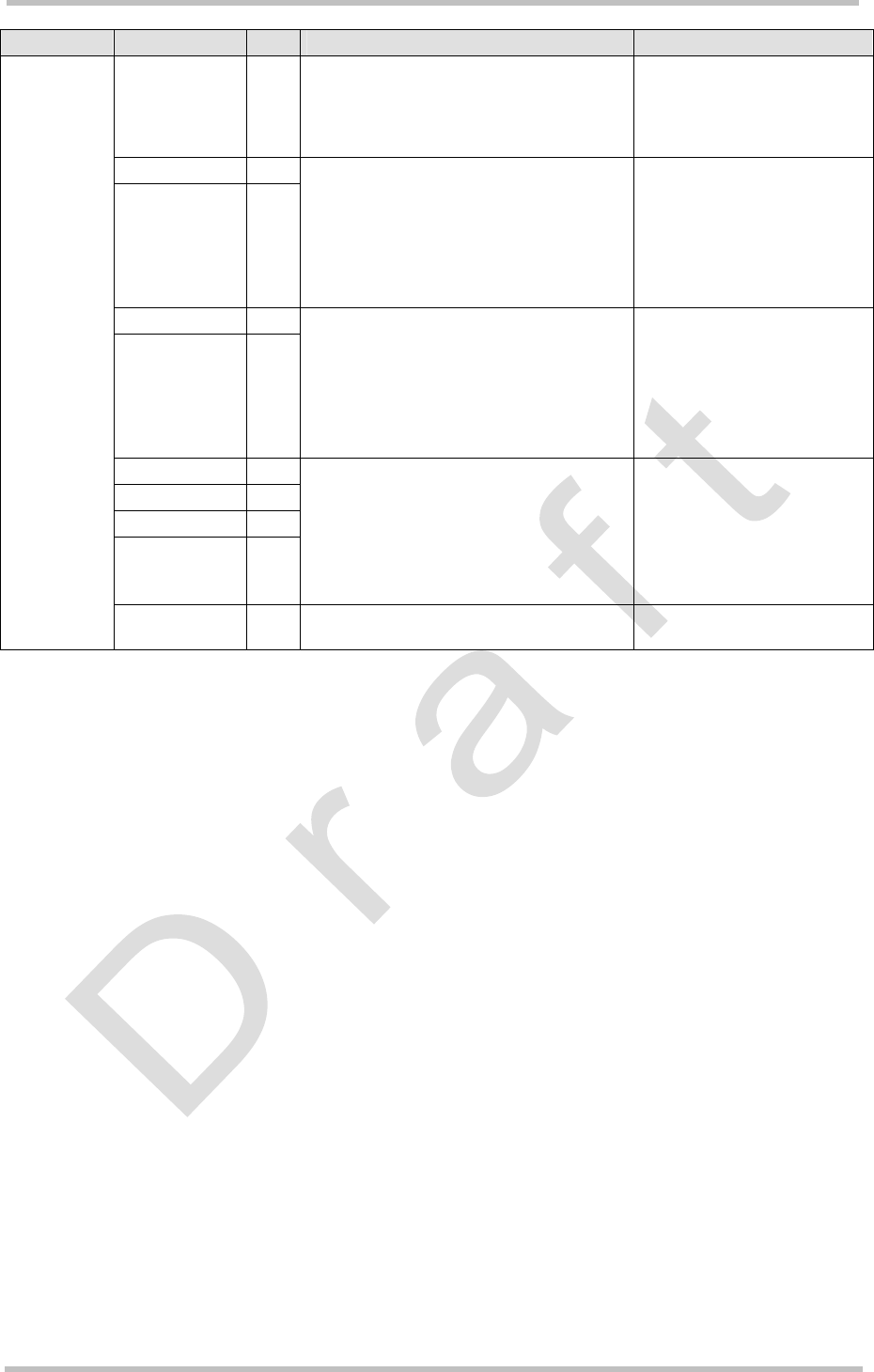
MC75 Hardware Interface Description
Strictly confidential / Draft s
MC75_V00.190a Page 71 of 91 15.02.2005
Function Signal name IO Signal form and level Comment
VMIC O VOmin = 2.4V
VOtyp = 2.5V
VOmax = 2.6V
Imax = 2mA
Microphone supply for
customer feeding circuits
EPP2 O
EPN2 O
1.0954Vpp (differential) typical
3.4Vpp differential maximal
Audio mode TBD
Measurement conditions TBD
Minimum differential resp. single
ended load 27 Ohms
The audio output can directly
operate a 32-Ohm-
loudspeaker.
If unused keep pins open.
EPP1 O
EPN1 O
1.0954Vpp (differential) typical
6.0 Vp-p differential maximal
Audio mode TBD
Measurement conditions TBD
Minimum differential resp. single
ended load 7.5 Ohms
The audio output can directly
operate an 8-Ohm-
loudspeaker.
If unused keep pins open.
MICP1 I
MICN1 I
MICP2 I
MICN2 I
Full Scale Input Voltage 1.578 Vpp
0dBm0 Input Voltage 1.0954 Vpp
At MICNx, apply external bias from 1.0V to
1.6V.
Audio mode TBD
Measurement conditions TBD
Balanced or single ended
microphone or line inputs with
external feeding circuit (using
VMIC and AGND).
If unused keep pins open.
Analog
Audio
interface
AGND Analog Ground GND level for external audio
circuits
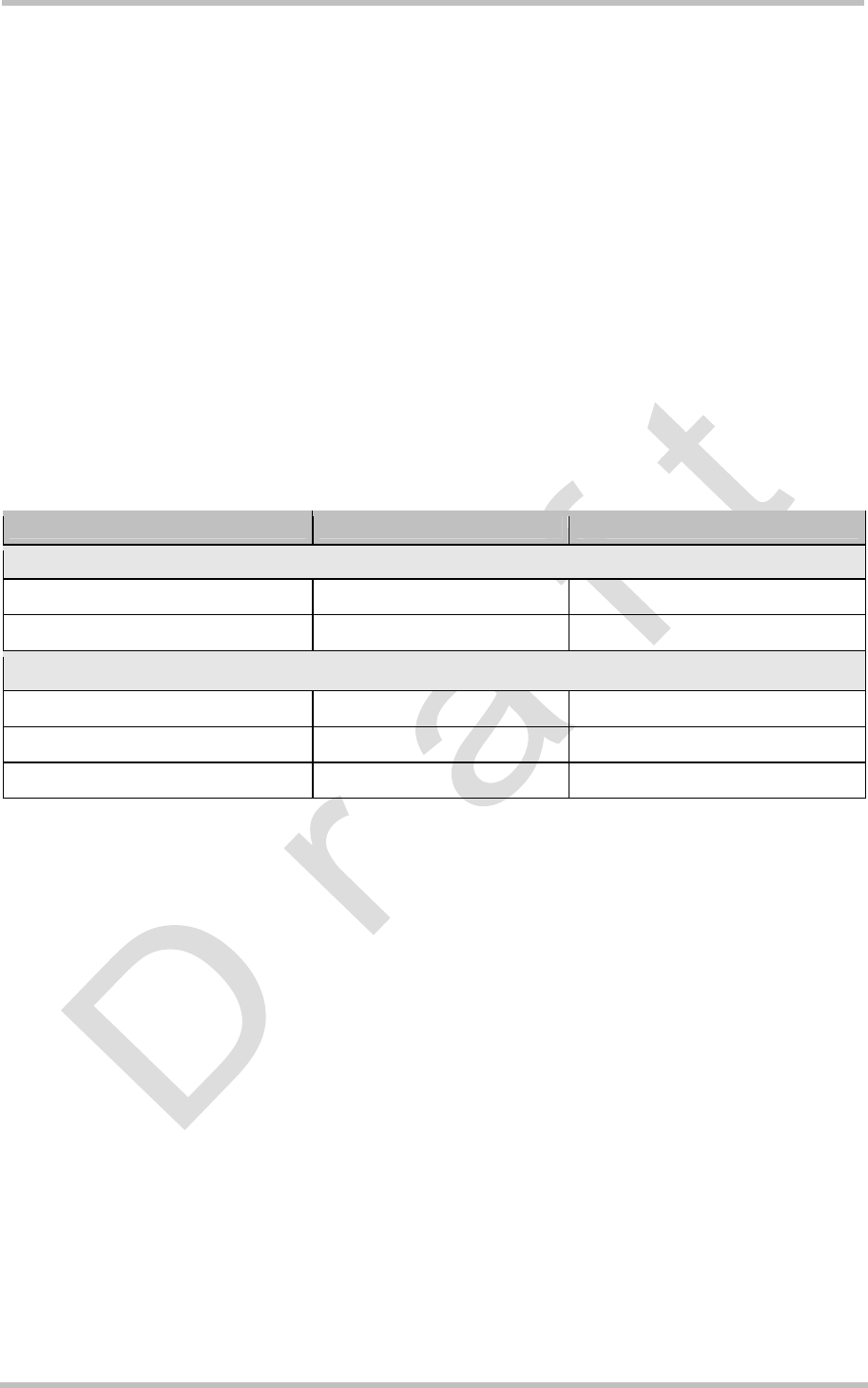
MC75 Hardware Interface Description
Strictly confidential / Draft s
MC75_V00.190a Page 72 of 91 15.02.2005
5.4 Electrostatic Discharge
The GSM engine is not protected against Electrostatic Discharge (ESD) in general.
Consequently, it is subject to ESD handling precautions that typically apply to ESD sensitive
components. Proper ESD handling and packaging procedures must be applied throughout
the processing, handling and operation of any application that incorporates a MC75 module.
Special ESD protection provided on MC75:
Antenna interface: one spark discharge line (spark gap)
SIM interface: clamp diodes for protection against overvoltage.
The remaining ports of MC75 are not accessible to the user of the final product (since they
are installed within the device) and therefore, are only protected according to the “Human
Body Model” requirements.
MC75 has been tested according to the EN 61000-4-2 standard. The measured values can
be gathered from the following table.
Table 17: Measured electrostatic values
Specification / Requirements Contact discharge Air discharge
ETSI EN 301 489-7
ESD at SIM port ± 4kV ± 8kV
ESD at antenna port ± 4kV ± 8kV
Human Body Model (Test conditions: 1.5 kΩ, 100 pF)
ESD at USB interface ± 1kV ± 1kV
ESD at SD card interface ± 1kV ± 1kV
ESD at all other interfaces ± 1kV ± 1kV
Note: Please note that the values may vary with the individual application design. For
example, it matters whether or not the application platform is grounded over external
devices like a computer or other equipment, such as the Siemens reference
application described in Chapter 8.
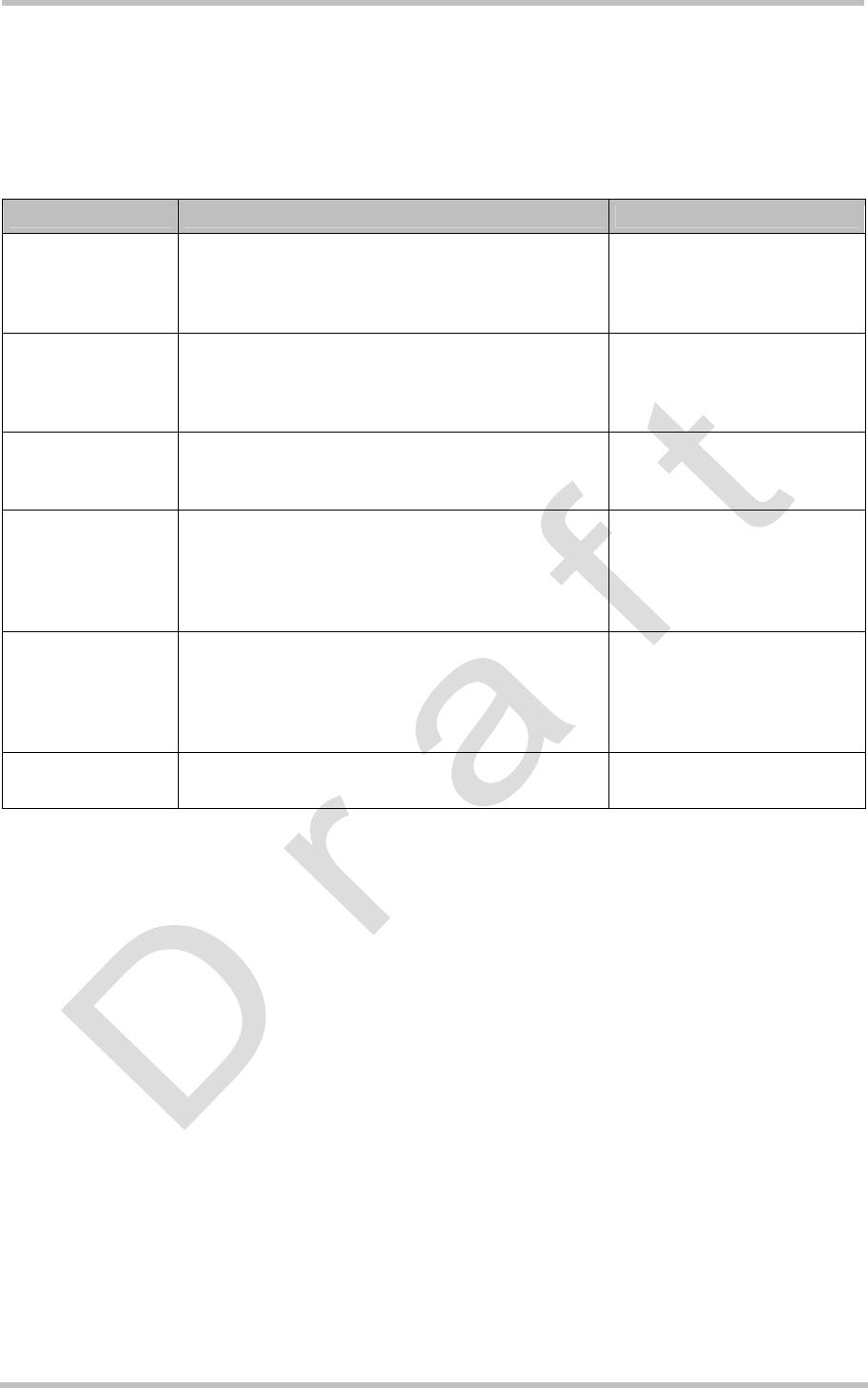
MC75 Hardware Interface Description
Strictly confidential / Draft s
MC75_V00.190a Page 73 of 91 15.02.2005
5.5 Reliability Characteristics
The test conditions stated below are an extract of the complete test specifications.
Table 18: Summary of reliability test conditions
Type of test Conditions Standard
Vibration Frequency range: 10-20 Hz; acceleration: 3.1mm
amplitude
Frequency range: 20-500 Hz; acceleration: 5g
Duration: 2h per axis = 10 cycles; 3 axes
DIN IEC 68-2-6
Shock half-sinus Acceleration: 500g
Shock duration: 1msec
1 shock per axis
6 positions (± x, y and z)
DIN IEC 68-2-27
Dry heat Temperature: +70 ±2°C
Test duration: 16 h
Humidity in the test chamber: < 50%
EN 60068-2-2 Bb ETS
300019-2-7
Temperature
change (shock)
Low temperature: -40°C ±2°C
High temperature: +85°C ±2°C
Changeover time: < 30s (dual chamber system)
Test duration: 1 h
Number of repetitions: 100
DIN IEC 68-2-14 Na
ETS 300019-2-7
Damp heat cyclic High temperature: +55°C ±2°C
Low temperature: +25°C ±2°C
Humidity: 93% ±3%
Number of repetitions: 6
Test duration: 12h + 12h
DIN IEC 68-2-30 Db
ETS 300019-2-5
Cold (constant
exposure)
Temperature: -40 ±2°C
Test duration: 16 h
DIN IEC 68-2-1
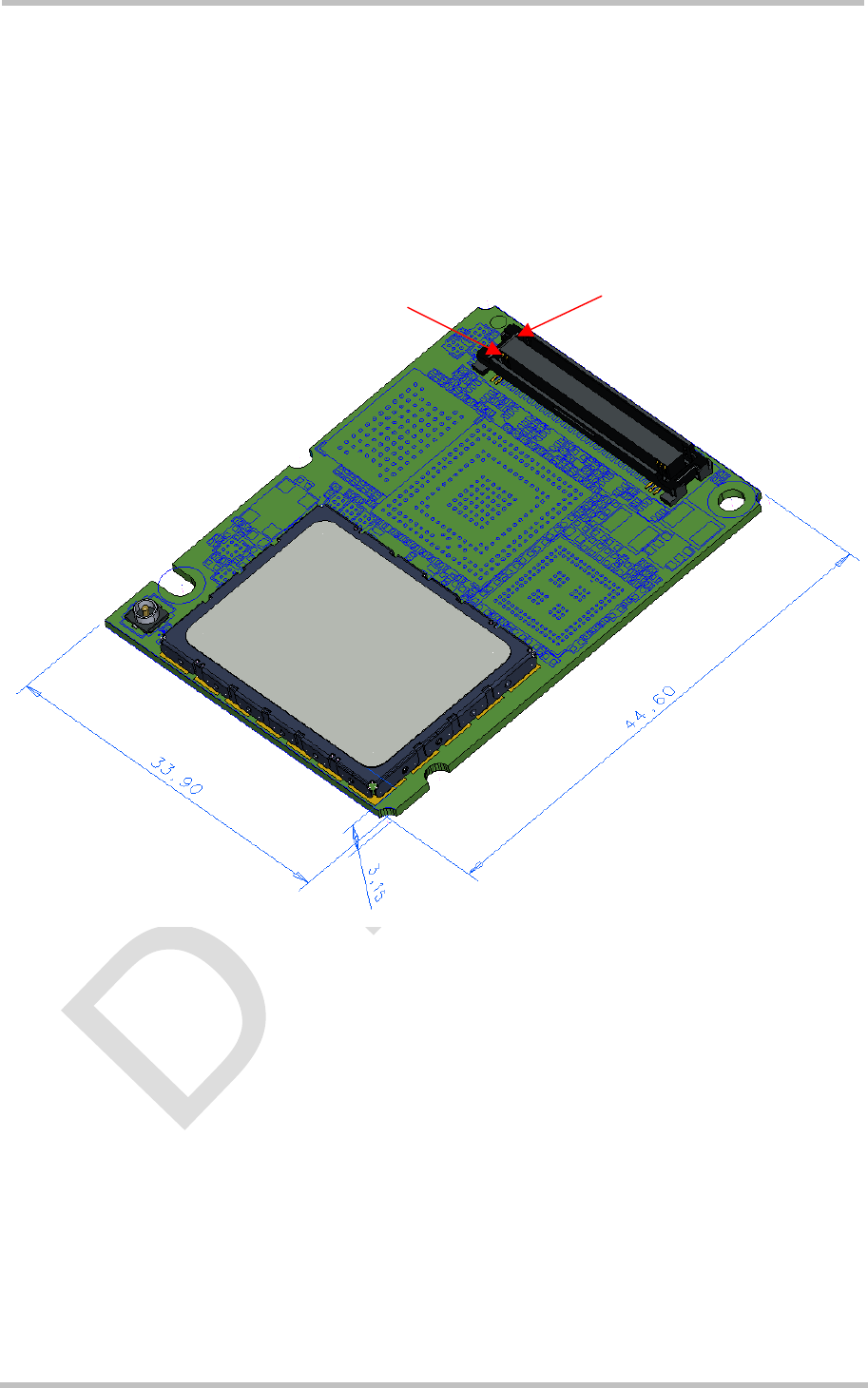
MC75 Hardware Interface Description
Strictly confidential / Draft s
MC75_V00.190a Page 74 of 91 15.02.2005
6 Mechanics
6.1 Mechanical Dimensions of MC75
Figure 35 shows the top view of MC75 and provides an overview of the board's mechanical
dimensions. For further details see Figure 36.
Figure 35: MC75 – top view
Pin 80
Pin 1
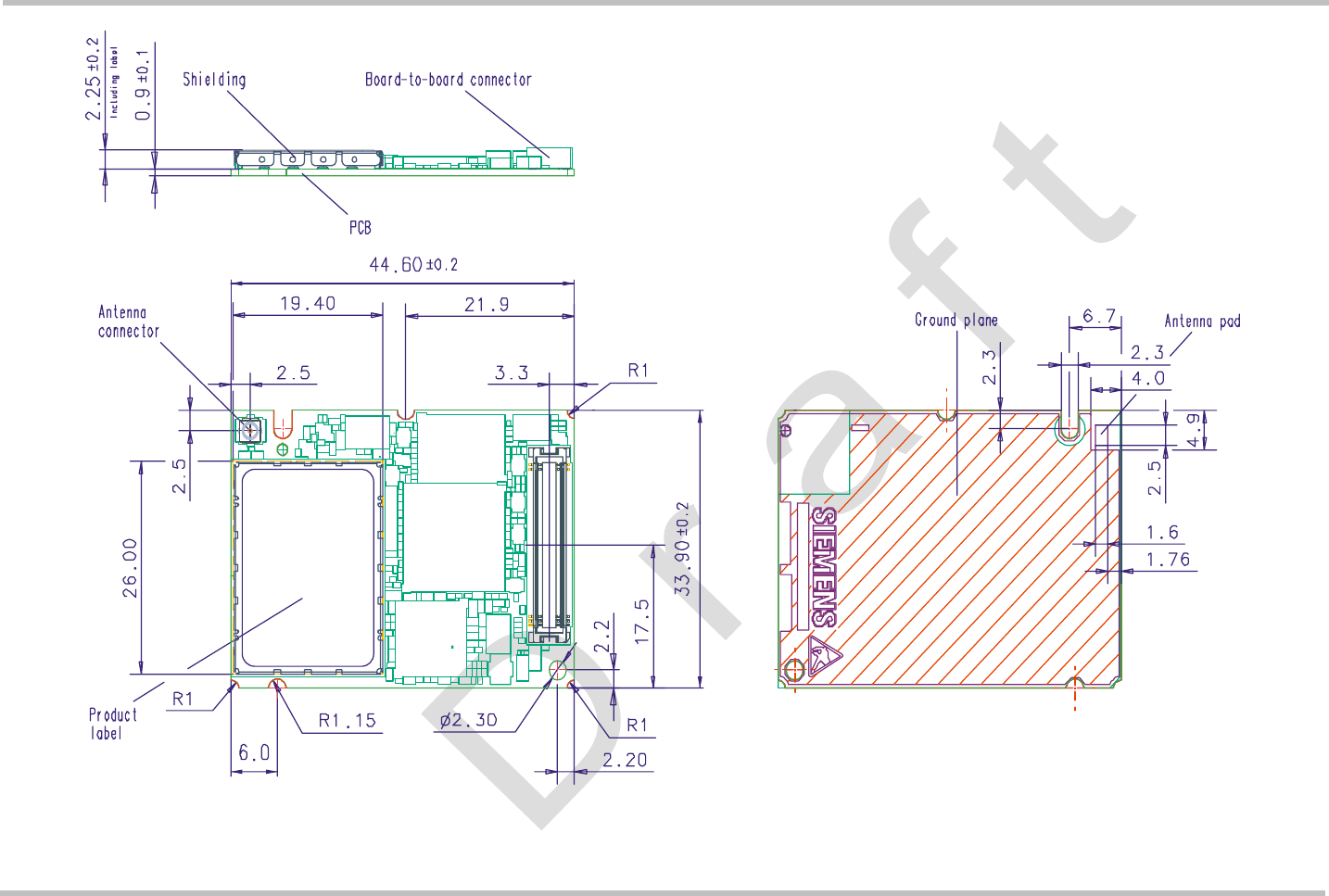
MC75 Hardware Interface Description
Strictly confidential / Draft s
MC75_V00.190a Page 75 of 91 15.02.2005
All dimensions in mm
Figure 36: Dimensions of MC75

MC75 Hardware Interface Description
Strictly confidential / Draft s
MC75_V00.190a Page 76 of 91 15.02.2005
6.2 Mounting MC75 to the Application Platform
There are many ways to properly install MC75 in the host device. An efficient approach is to
mount the MC75 PCB to a frame, plate, rack or chassis.
Fasteners can be M2 screws plus suitable washers, circuit board spacers, or customized
screws, clamps, or brackets. In addition, the board-to-board connection can also be utilized
to achieve better support. To help you find appropriate spacers a list of selected screws and
distance sleeves for 3mm stacking height can be found in Section 9.2.
When using the two small holes take care that the screws are inserted with the screw head
on the bottom of the MC75 PCB. Screws for the large holes can be inserted from top or
bottom.
For proper grounding it is strongly recommended to use large ground plane on the bottom of
board in addition to the five GND pins of the board-to-board connector. The ground plane
may also be used to attach cooling elements, e.g. a heat sink or thermally conductive tape.
To prevent mechanical damage, be careful not to force, bend or twist the module. Be sure it
is positioned flat against the host device.
All the information you need to install an antenna is summarized in Chapter 4. Note that the
antenna pad on the bottom of the MC75 PCB must not be influenced by any other PCBs,
components or by the housing of the host device. It needs to be surrounded by a restricted
space as described in Section 4.1.
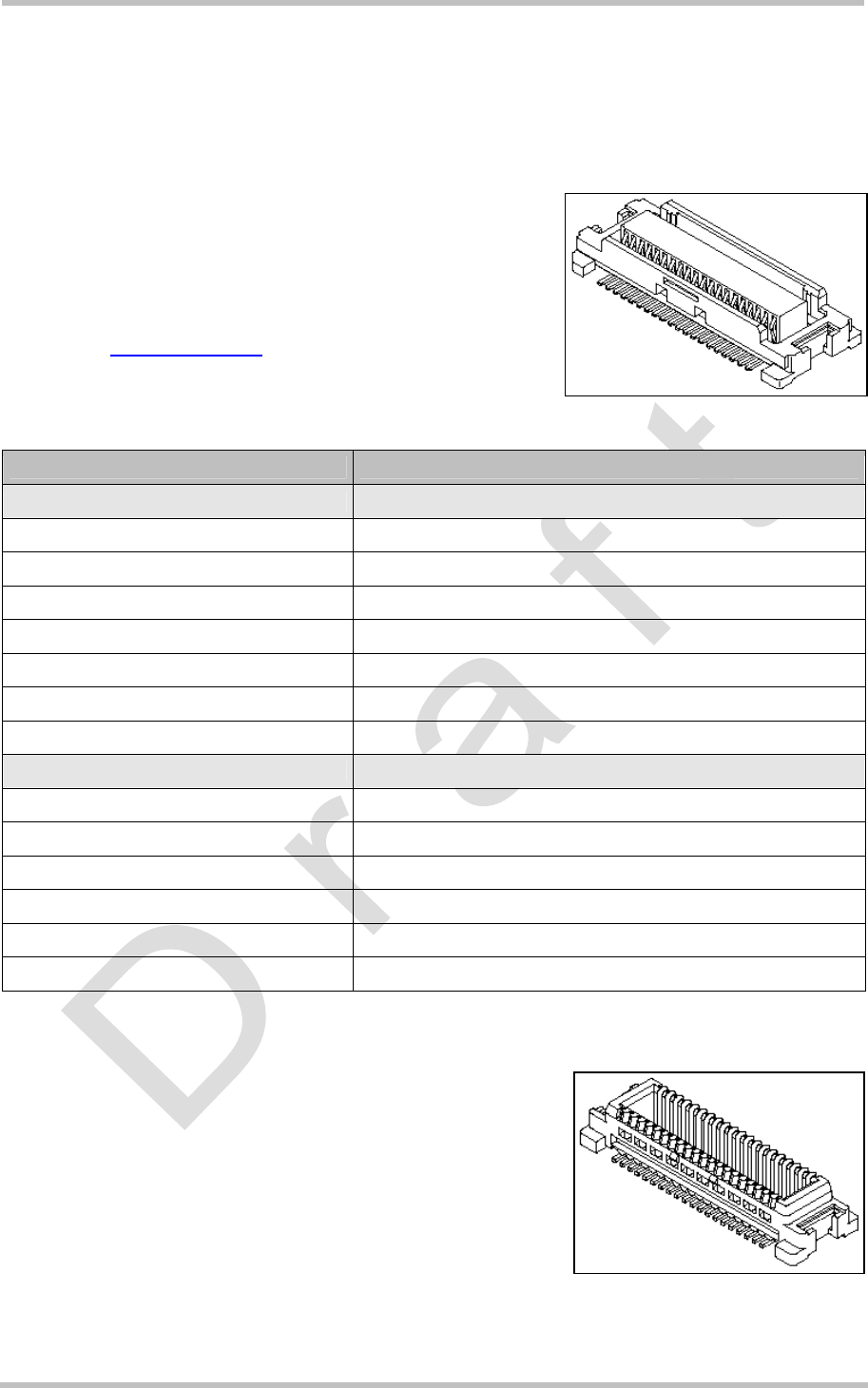
MC75 Hardware Interface Description
Strictly confidential / Draft s
MC75_V00.190a Page 77 of 91 15.02.2005
6.3 Board-to-Board Application Connector
This section provides the specifications of the 80-pin board-to-board connector used to
connect MC75 to the external application.
Connector mounted on the MC75 module:
Type: 52991-0808 SlimStack Receptacle
80 pins, 0.50mm pitch,
for stacking heights from 3.0 to 4.0mm,
see Figure 37 for details.
Supplier: Molex
www.molex.com
Table 19: Technical specifications of Molex board-to-board connector
Parameter Specification (80-pin B2B connector)
Electrical
Number of Contacts 80
Contact spacing 0.5mm (.020")
Voltage 50V
Rated current 0.5 A max per contact
Contact resistance 50mΩ max per contact
Insulation resistance > 100 MΩ
Dielectric Withstanding Voltage 500 V AC (for 1 minute)
Physical
Insulator material (housing) White glass-filled LCP plastic, flammability UL 94V 0
Contact material Plating: Gold over nickel
Insertion force 1st < 74.4 N
Insertion force 30th < 65.6 N
Withdrawal force 1st > 10.8 N
Maximum connection cycles 30 (@ 70mΩ max per contact)
Mating connector types for the customer's application
offered by Molex:
• 53748-0808 SlimStack Plug, 3mm stacking height,
see Figure 38 for details.
• 53916-0808 SlimStack Plug, 4mm stacking height
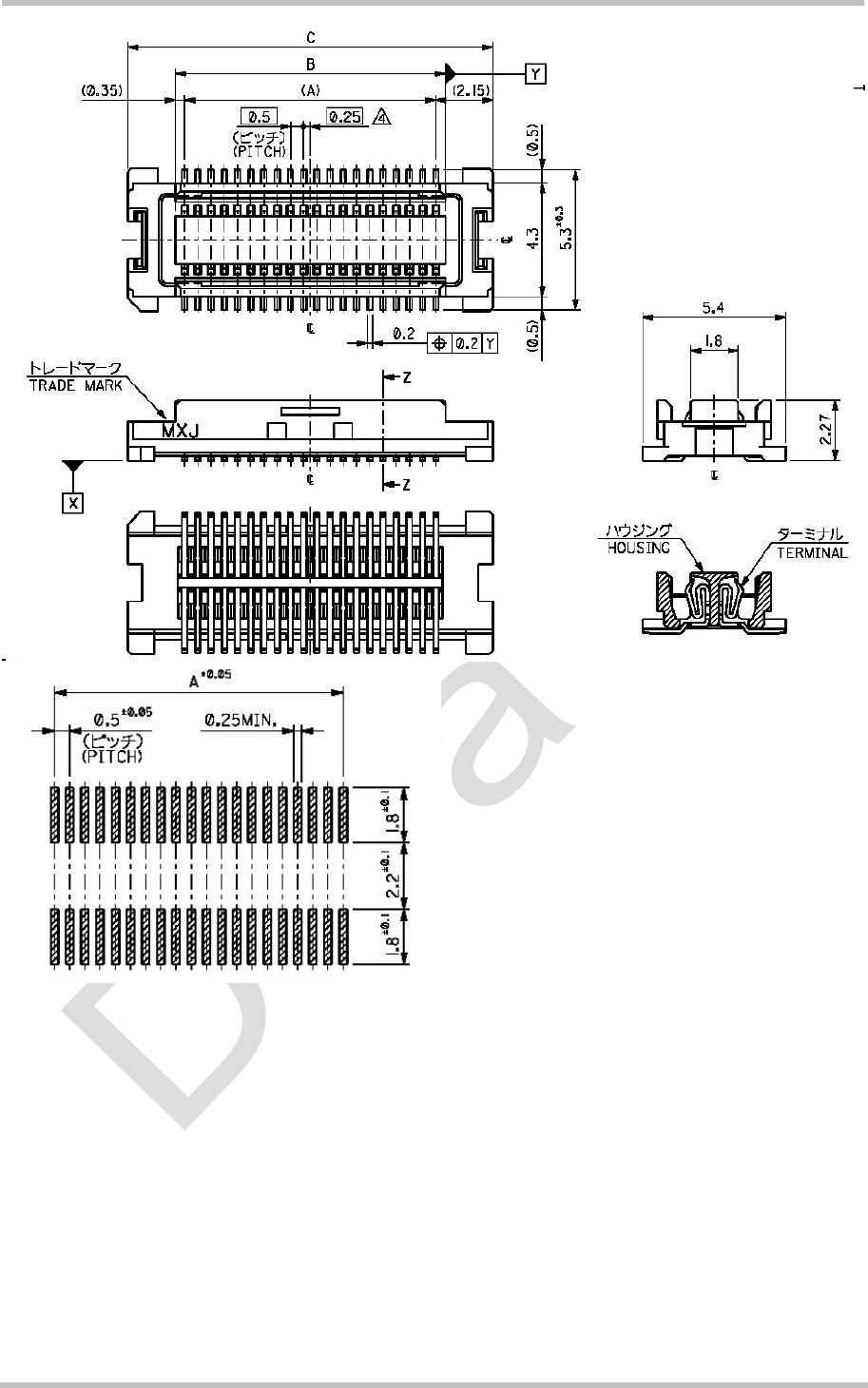
MC75 Hardware Interface Description
Strictly confidential / Draft s
MC75_V00.190a Page 78 of 91 15.02.2005
Figure 37: Molex board-to-board connector 52991-0808 on MC75
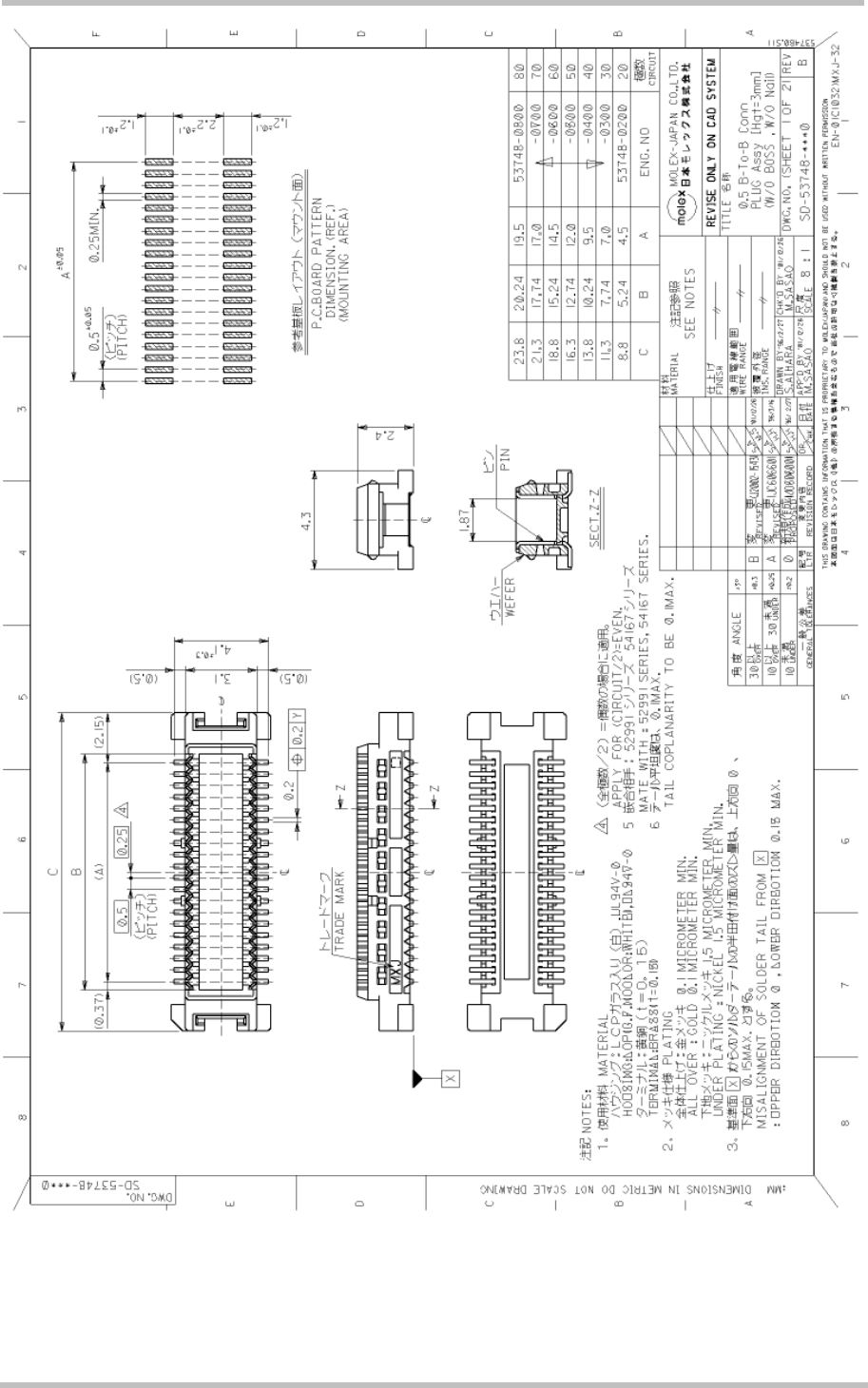
MC75 Hardware Interface Description
Strictly confidential / Draft s
MC75_V00.190a Page 79 of 91 15.02.2005
Figure 38: Mating board-to-board connector 53748-0808 on application

MC75 Hardware Interface Description
Strictly confidential / Draft s
MC75_V00.190a Page 80 of 91 15.02.2005
7 Sample Application
Figure 39 shows a typical example of how to integrate a MC75 module into the GSM part of
a mobile application. Usage of the various host interfaces depends on the desired features of
the application.
Audio interface 1 demonstrates the balanced connection of microphone and earpiece. This
solution is particularly well suited for internal transducers. Audio interface 2 uses an
unbalanced microphone and earpiece connection typically found in headset applications.
The charging circuit is optimized for the charging stages (trickle charging and software
controlled charging) as well as the battery and charger specifications described in Section
3.4.
The PWR_IND line is an open collector that needs an external pull-up resistor which
connects to the voltage supply of the microcontroller VCC µC. Low state of the open collector
pulls the PWR_IND signal low and indicates that the MC75 module is active, high level
notifies the Power-down mode.
If the module is in Power-down mode avoid current flowing from any other source into the
module circuit, for example reverse current from high state external control lines. Therefore,
the controlling application must be designed to prevent reverse or return flow. This is not
necessary for the USB interface.
The SD memory card interface can be powered from an external supply or via the VEXT line
of MC75. Figure 39 uses the VEXT line. The advantage of this solution is that when the
module enters the Power-down mode, the SD memory card interface is shut down as well. If
you prefer to connect an SD card to an external power supply, take care that the interface is
shut down when the PWR_IND signal goes high in Power-down mode. The same applies to
the I2C interface.
The EMC measures are best practice recommendations. In fact, an adequate EMC strategy
for an individual application is very much determined by the overall layout and, especially,
the position of components. For example, mounting the internal acoustic transducers directly
on the PCB eliminates the need to use the ferrite beads shown in the sample schematic.
However, when connecting cables to the module’s interfaces it is strongly recommended to
add appropriate ferrite beads for reducing RF radiation.
Disclaimer
No warranty, either stated or implied, is provided on the sample schematic diagram shown in
Figure 39 and the information detailed in this section. As functionality and compliance with
national regulations depend to a great amount on the used electronic components and the
individual application layout manufacturers are required to ensure adequate design and
operating safeguards for their products using MC75 modules.
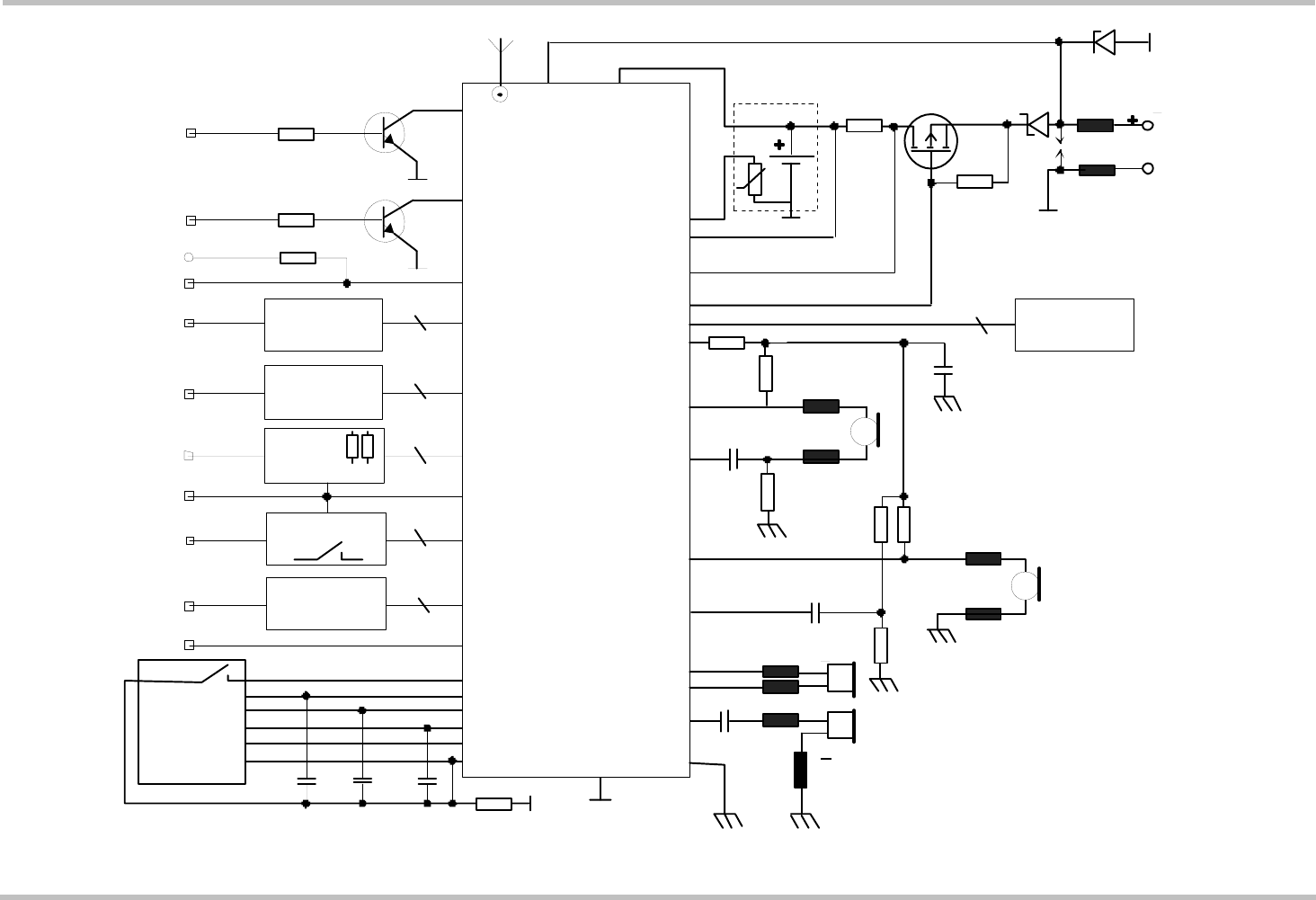
MC75 Hardware Interface Description
Strictly confidential / Draft s
MC75_V00.190a Page 81 of 91 15.02.2005
Rechargeable
Lithium battery
Charger
ESD
protection
NTC
2.7k
SI3441DV
0.3R
47k
100k
VCC µC
47k
EMERG_RST
PWR_IND
IGT
BATT+
VCHARGE
BATTEMP
VSENSE
ISENSE
CHARGEGATE
CCGND
CCCLK
CCIO
CCRST
CCIN
CCVCC
200nF
SIM
VMIC (2.5V)
GND AGND
MICP1
MICP2
EPN1
EPP1
EPP2
EPN2
MC75
MICN1
MICN2
1k
1k
2.2k2.2k
5.6k
100nF
100nF
22µF
Digital Audio
7
100µF
BC847
BC847
VEXT (2.9V)
SYNC
>8R
>32R
*)
depends on final specification
CRS04
All SIM components shall be close to card holder.
1nF 27pF
0R (not mounted)
V 5.2V 0.2V
ch ar ge
+
Serial Interface
ASC0
Serial Interface
ASC1
SD memory
card
*)
USB
(Slave)
*)
MC75 Application
(Draft)
*)
8
8
3
4
*)
I2C
2
2 x R
P
470R
Figure 39: MC75 sample application (draft)
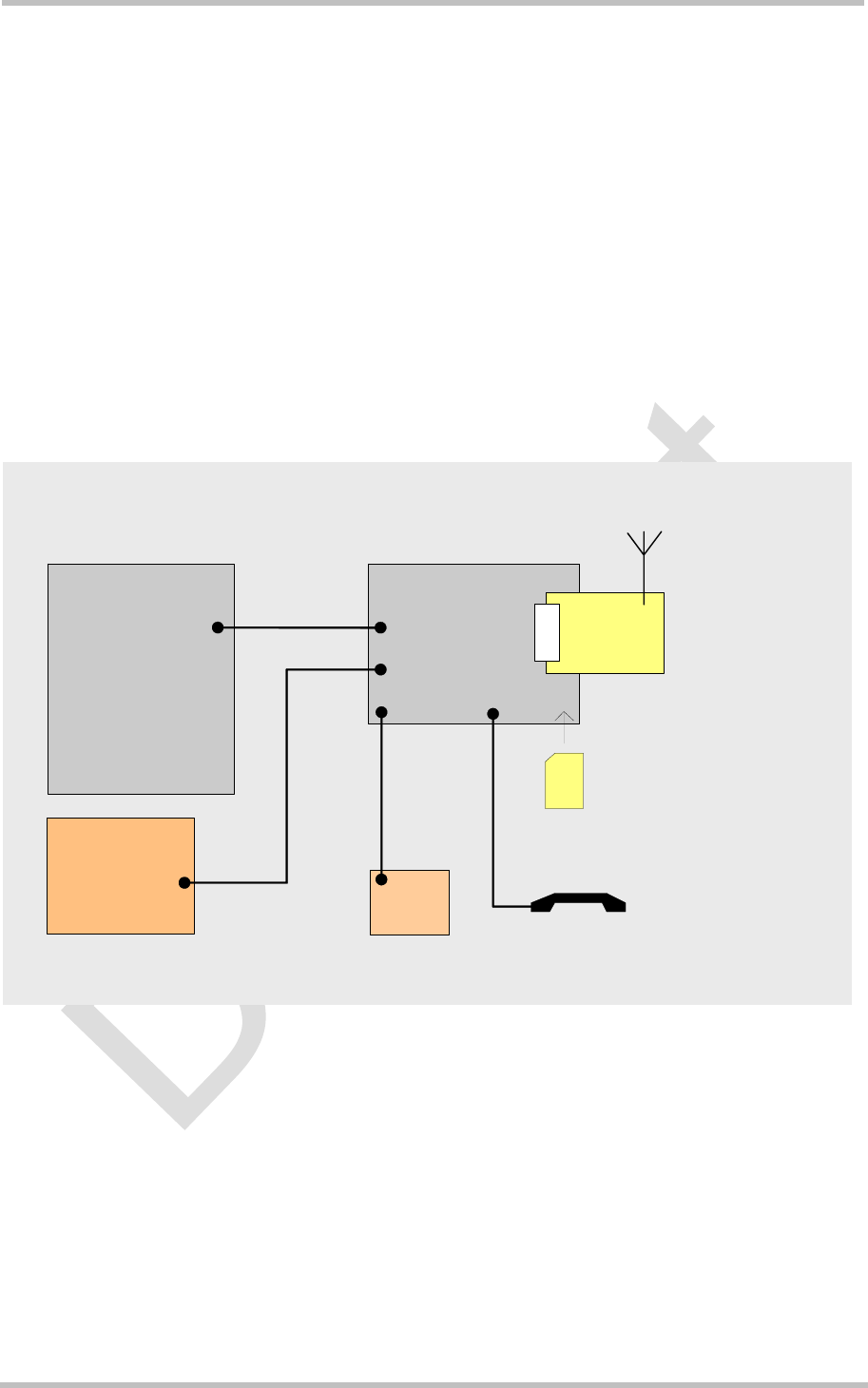
MC75 Hardware Interface Description
Strictly confidential / Draft s
MC75_V00.190a Page 82 of 91 15.02.2005
8 Reference Approval
8.1 Reference Equipment for Type Approval
The Siemens reference setup submitted to type approve MC75 consists of the following
components:
• Siemens MC75 cellular engine
• Development Support Box DSB75
• SIM card reader integrated on DSB75
• U.FL-R-SMT antenna connector and U.FL-LP antenna cable
• Handset type Votronic HH-SI-30.3/V1.1/0
• Li-Ion battery
• PC as MMI
GSM engine
PC
Power supply
SIM
RS-232 DSB75
Handset
50 Ω antenna
connector (ARP)
B2B
Li-Ion
battery
Figure 40: Reference equipment for Type Approval

MC75 Hardware Interface Description
Strictly confidential / Draft s
MC75_V00.190a Page 83 of 91 15.02.2005
8.2 Compliance with FCC Rules and Regulations
The FCC Equipment Authorization Certification for the MC75 reference application described
in Section 8.1 is listed under the
FCC identifier QIPMC75
IC: 267W-MC75
granted to Siemens AG.
The MC75 reference application registered under the above identifier is certified to be in
accordance with the following Rules and Regulations of the Federal Communications
Commission (FCC).
Power listed is ERP for Part 22 and EIRP for Part 24
“This device contains GSM, GPRS Class12 and EGPRS Class 10 functions in the 900
and 1800MHz Band which are not operational in U.S. Territories.
This device is to be used only for mobile and fixed applications. The antenna(s) used
for this transmitter must be installed to provide a separation distance of at least 20cm
from all persons and must not be co-located or operating in conjunction with any other
antenna or transmitter. Users and installers must be provided with antenna installation
instructions and transmitter operating conditions for satisfying RF exposure com-
pliance. Antennas used for this OEM module must not exceed 8.4dBi gain (GSM 1900)
and 2.9dBi (GSM 850) for mobile and fixed operating configurations. This device is
approved as a module to be installed in other devices.
The FCC label of the module must be visible from the outside. If not, the host device is
required to bear a second label stating, “Contains FCC ID QIPMC75”.
IMPORTANT: Manufacturers of mobile or fixed devices incorporating MC75 modules are
advised to
• clarify any regulatory questions,
• have their completed product tested,
• have product approved for FCC compliance, and
• include instructions according to above mentioned RF exposure statements in end
product user manual.
Please note that changes or modifications not expressly approved by the party responsible
for compliance could void the user’s authority to operate the equipment.
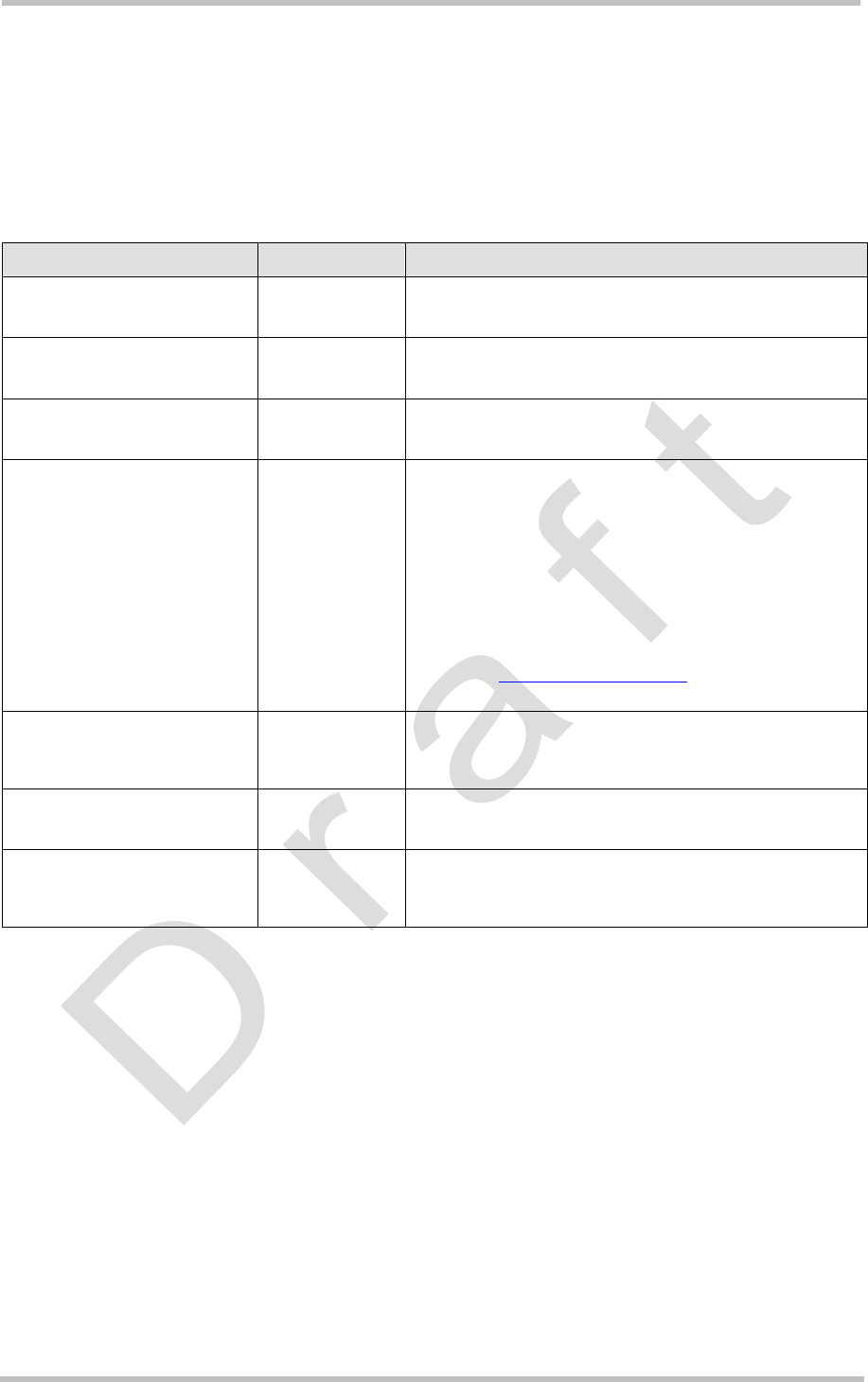
MC75 Hardware Interface Description
Strictly confidential / Draft s
MC75_V00.190a Page 84 of 91 15.02.2005
9 Appendix
9.1 List of Parts and Accessories
Table 20: List of parts and accessories
Description Supplier Ordering information
MC75 Siemens Siemens ordering number: L36880-N8810-N100
Siemens Car Kit Portable Siemens Siemens ordering number: L36880-N3015-A117
DSB75 Support Box Siemens Siemens ordering number:
Votronic Handset VOTRONIC Votronic HH-SI-30.3/V1.1/0
VOTRONIC
Entwicklungs- und Produktionsgesellschaft für
elektronische Geräte mbH
Saarbrücker Str. 8
66386 St. Ingbert
Germany
Phone: +49-(0)6 89 4 / 92 55-0
Fax: +49-(0)6 89 4 / 92 55-88
e-mail: contact@votronic.com
SIM card holder incl. push
button ejector and slide-in
tray
Molex Ordering numbers: 91228
91236
Sales contacts are listed in Table 21.
Board-to-board connector Molex Sales contacts are listed in Table 21.
U.FL-R-SMT antenna
connector
Hirose See Section 4.3 for details on U.FL-R-SMT
connector, mating plugs and cables.
Sales contacts are listed in Table 22.
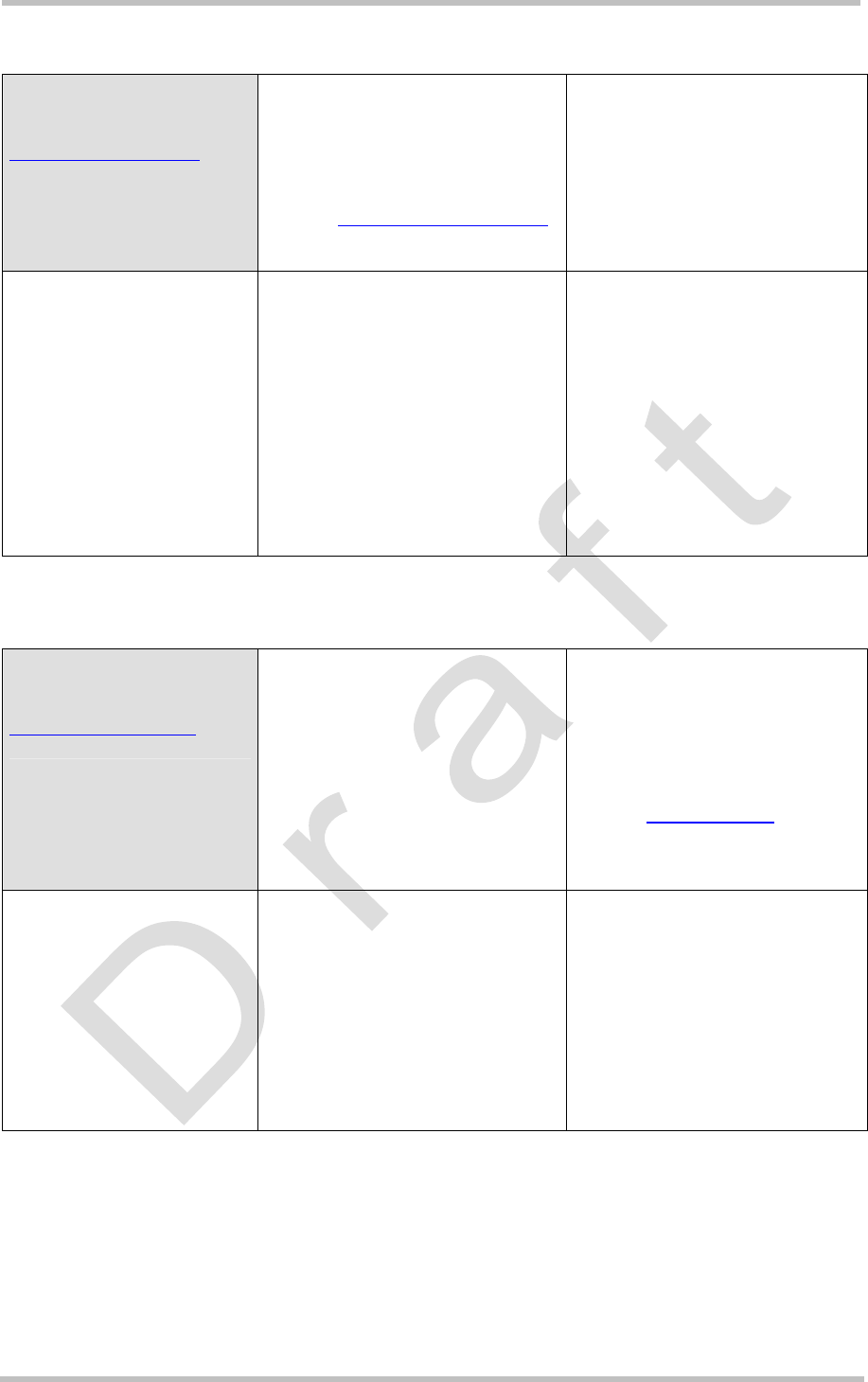
MC75 Hardware Interface Description
Strictly confidential / Draft s
MC75_V00.190a Page 85 of 91 15.02.2005
Table 21: Molex sales contacts (subject to change)
Molex
For further information
please click:
http://www.molex.com/
Molex Deutschland GmbH
Felix-Wankel-Str. 11
4078 Heilbronn-Biberach
Germany
Phone: +49-7066-9555 0
Fax: +49-7066-9555 29
Email: mxgermany@molex.com
American Headquarters
Lisle, Illinois 60532
U.S.A.
Phone: +1-800-78MOLEX
Fax: +1-630-969-1352
Molex China Distributors
Beijing,
Room 1319, Tower B,
COFCO Plaza
No. 8, Jian Guo Men Nei
Street, 100005
Beijing
P.R. China
Phone: +86-10-6526-9628
Phone: +86-10-6526-9728
Phone: +86-10-6526-9731
Fax: +86-10-6526-9730
Molex Singapore Pte. Ltd.
Jurong, Singapore
Phone: +65-268-6868
Fax: +65-265-6044
Molex Japan Co. Ltd.
Yamato, Kanagawa, Japan
Phone: +81-462-65-2324
Fax: +81-462-65-2366
Table 22: Hirose sales contacts (subject to change)
Hirose Ltd.
For further information
please click:
http://www.hirose.com
Hirose Electric (U.S.A.) Inc
2688 Westhills Court
Simi Valley, CA 93065
U.S.A.
Phone: +1-805-522-7958
Fax: +1-805-522-3217
Hirose Electric GmbH
Zeppelinstrasse 42
73760 Ostfildern
Kemnat 4
Germany
Phone: +49-711-4560-021
Fax +49-711-4560-729
E-mail info@hirose.de
Hirose Electric UK, Ltd
Crownhill Business Centre
22 Vincent Avenue,
Crownhill
Milton Keynes, MK8 OAB
Great Britain
Phone: +44-1908-305400
Fax: +44-1908-305401
Hirose Electric Co., Ltd.
5-23, Osaki 5 Chome,
Shinagawa-Ku
Tokyo 141
Japan
Phone: +81-03-3491-9741
Fax: +81-03-3493-2933
Hirose Electric Co., Ltd.
European Branche
First class Building 4F
Beechavenue 46
1119PV Schiphol-Rijk
Netherlands
Phone: +31-20-6557-460
Fax: +31-20-6557-469
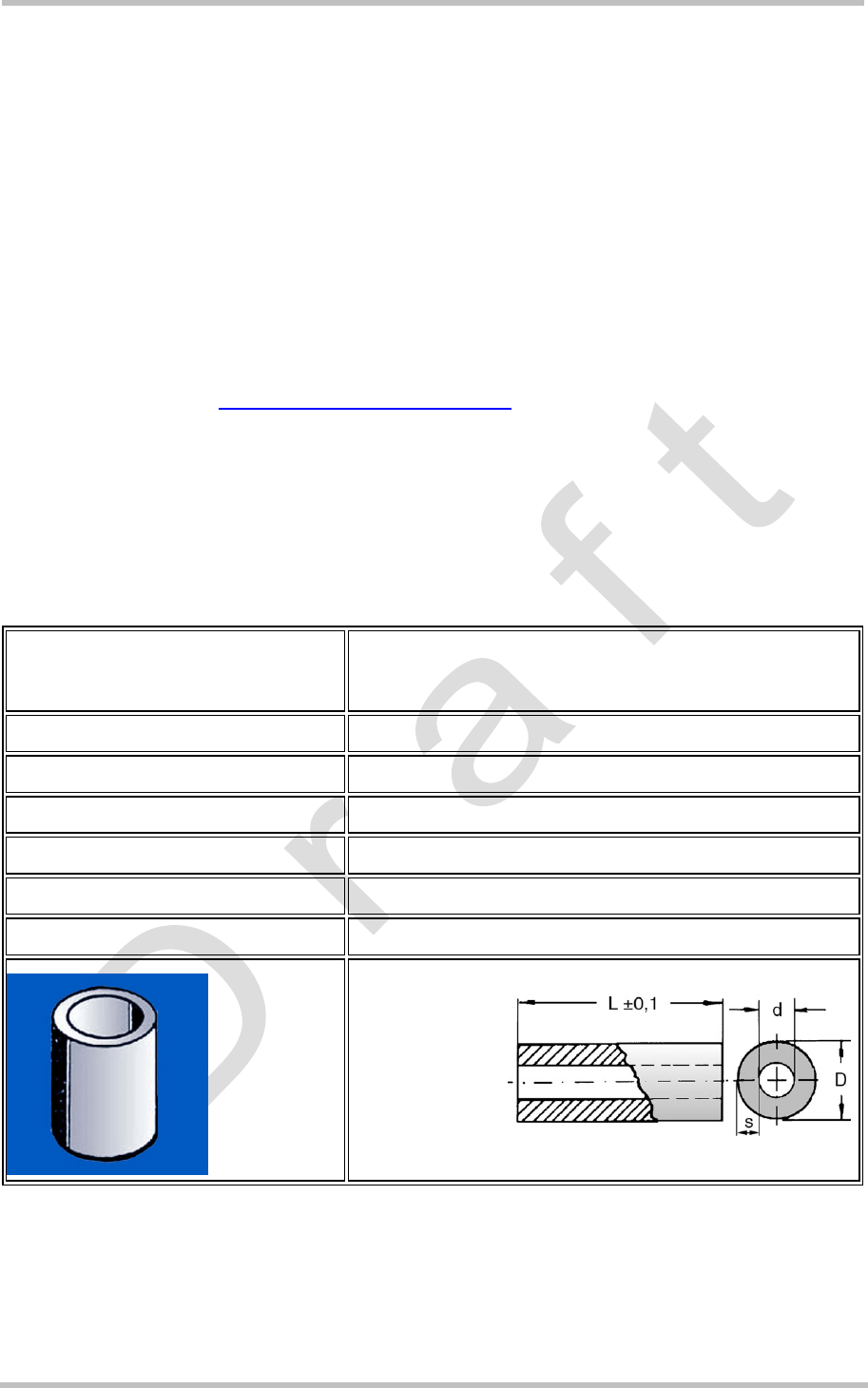
MC75 Hardware Interface Description
Strictly confidential / Draft s
MC75_V00.190a Page 86 of 91 15.02.2005
9.2 Fasteners and Fixings for Electronic Equipment
This section provides a list of suppliers and manufacturers offering fasteners and fixings for
electronic equipment and PCB mounting. The content of this section is designed to offer
basic guidance to various mounting solutions with no warranty on the accuracy and
sufficiency of the information supplied. Please note that the list remains preliminary although
it is going to be updated in later versions of this document.
9.2.1 Fasteners from German Supplier ETTINGER GmbH
Sales contact: ETTINGER GmbH
http://www.ettinger.de/main.cfm
Phone: +4981 04 66 23 – 0
Fax: +4981 04 66 23 – 0
The following tables contain only article numbers and basic parameters of the listed
components. For further detail and ordering information please contact Ettinger GmbH.
Please note that some of the listed screws, spacers and nuts are delivered with the DSB75
Support Board. See comments below.
Article number: 05.71.038
Spacer - Aluminum /
Wall thickness = 0.8mm
Length 3.0 mm
Material AlMgSi-0,5
For internal diameter M2=2.0-2.3
Internal diameter d = 2.4 mm
External diameter 4.0 mm
Vogt AG No. x40030080.10
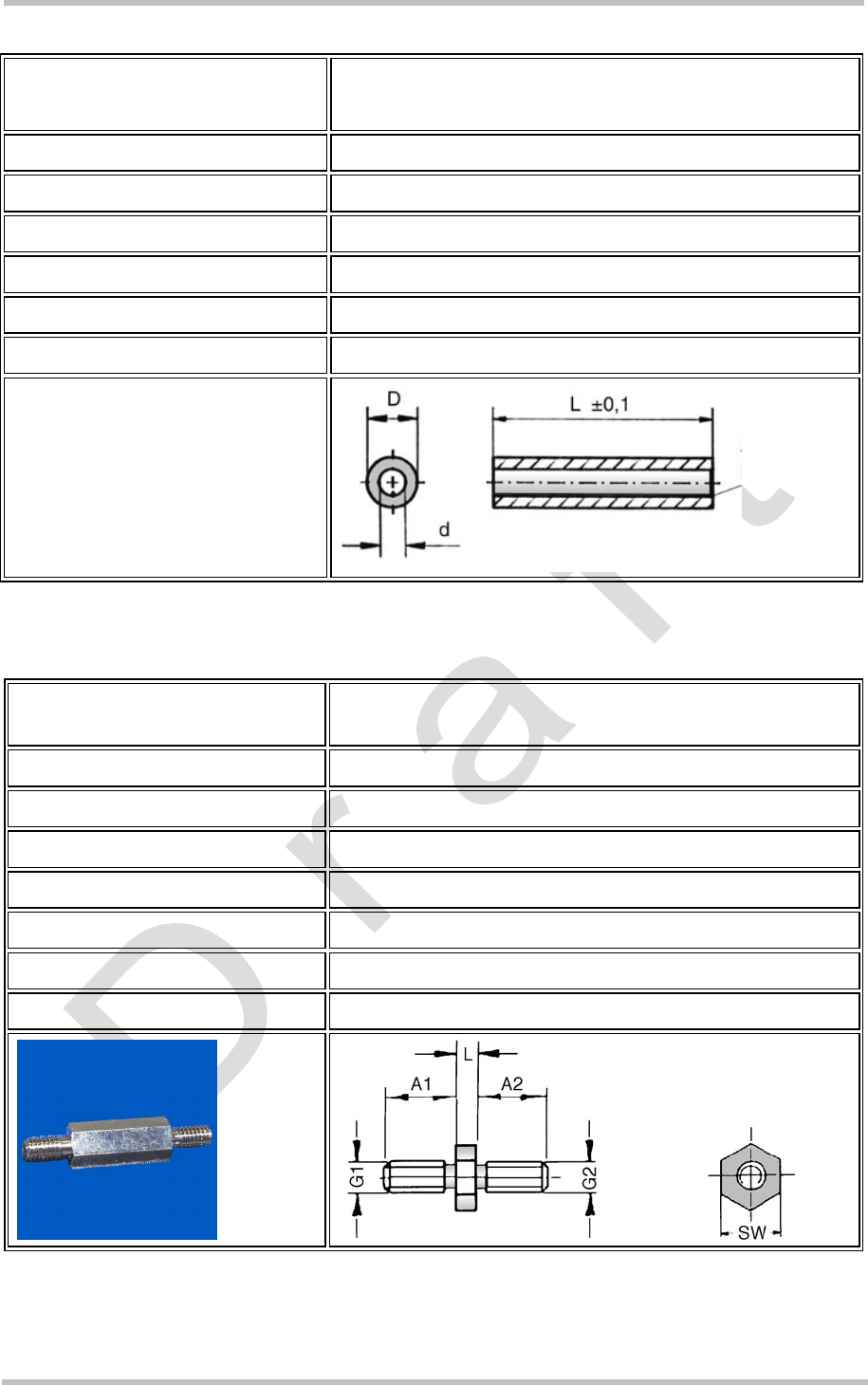
MC75 Hardware Interface Description
Strictly confidential / Draft s
MC75_V00.190a Page 87 of 91 15.02.2005
Article number: 07.51.403
Insulating Spacer for M2
Self-gripping *)
Length 3.0 mm
Material Polyamide 6.6
Surface Black
Internal diameter 2.2 mm
External diameter 4.0 mm
Flammability rating UL94-HB
*) 2 spacers are delivered with DSB75 Support Board
Article number: 05.11.209
Threaded Stud M2.5 - M2 Type E /
External thread at both ends
Length 3.0 mm
Material Stainless steel X12CrMoS17
Thread 1 / Length M2.5 / 6.0 mm
Thread 2 / Length M2 / 8.0 mm
Width across flats 5
Recess yes
Type External / External
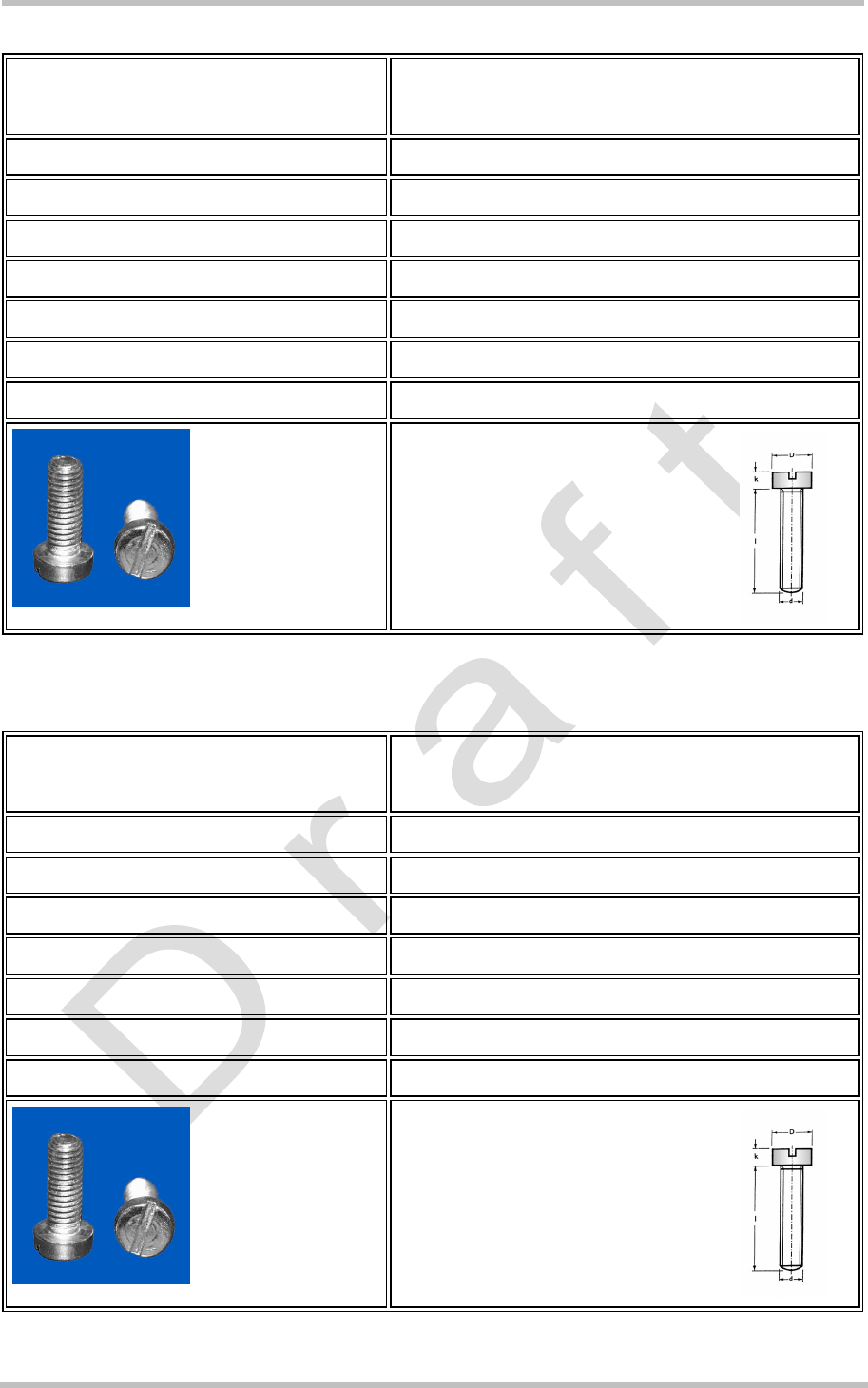
MC75 Hardware Interface Description
Strictly confidential / Draft s
MC75_V00.190a Page 88 of 91 15.02.2005
Article number: 01.14.131 Screw M2 *)
DIN 84 - ISO 1207
Length 8.0 mm
Material Steel 4.8
Surface Zinced A2K
Thread M2
Head diameter D = 3.8 mm
Head height 1.30 mm
Type Slotted cheese head screw
*) 2 screws are delivered with DSB75 Support Board
Article number: 01.14.141 Screw M2
DIN 84 - ISO 1207
Length 10.0 mm
Material Steel 4.8
Surface Zinced A2K
Thread M2
Head diameter D = 3.8 mm
Head height 1.30 mm
Type Slotted cheese head screw
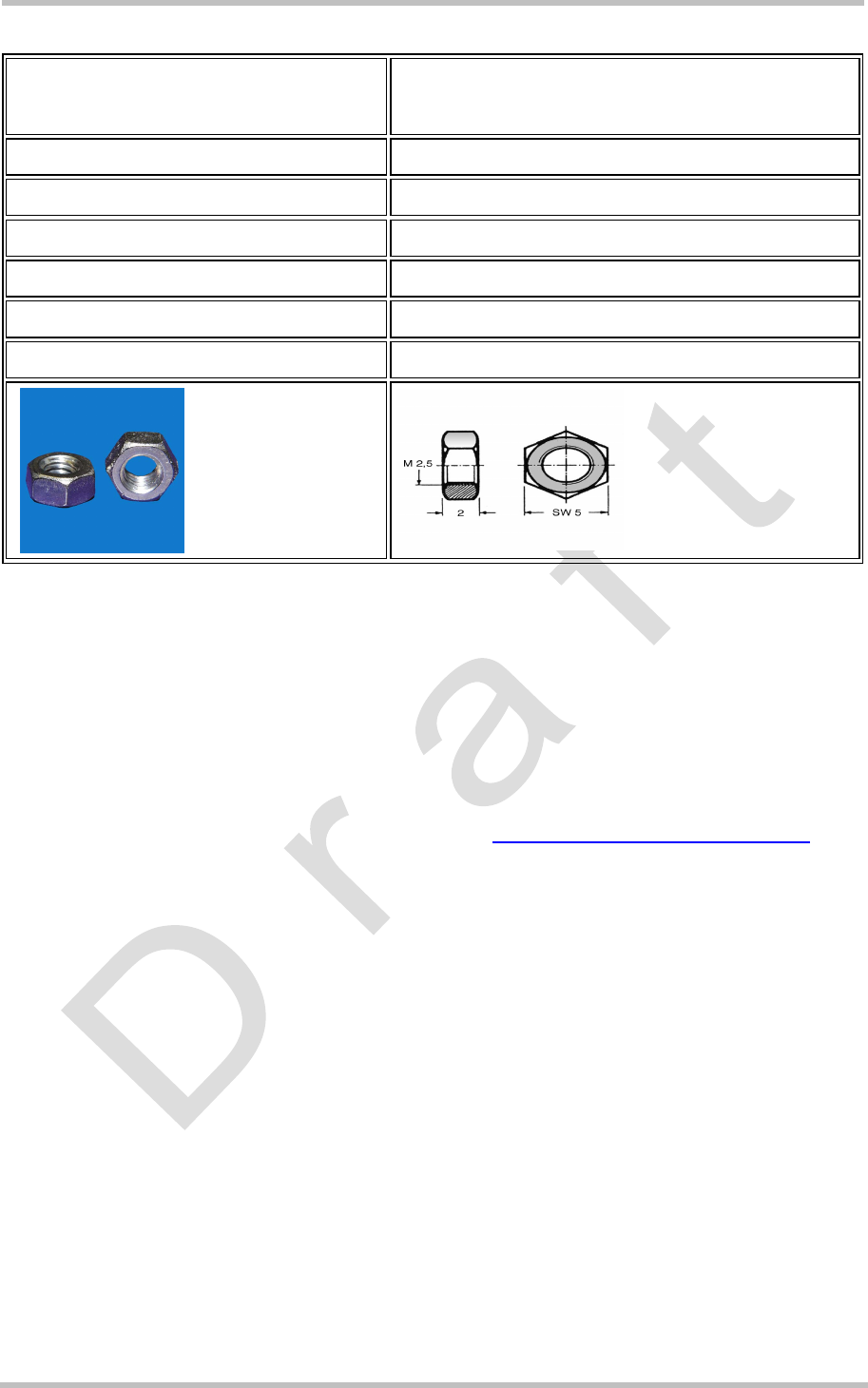
MC75 Hardware Interface Description
Strictly confidential / Draft s
MC75_V00.190a Page 89 of 91 15.02.2005
Article number: 02.10.011 Hexagon Nut *)
DIN 934 - ISO 4032
Material Steel 4.8
Surface Zinced A2K
Thread M2
Wrench size / Ø 4
Thickness / L 1.6 mm
Type Nut DIN/UNC, DIN934
*) 2 nuts are delivered with DSB75 Support Board
9.3 Data Sheets of Recommended Batteries
The following two data sheets have been provided by VARTA Microbattery GmbH.
Click here for sales contacts and further information: http://www.varta-microbattery.com
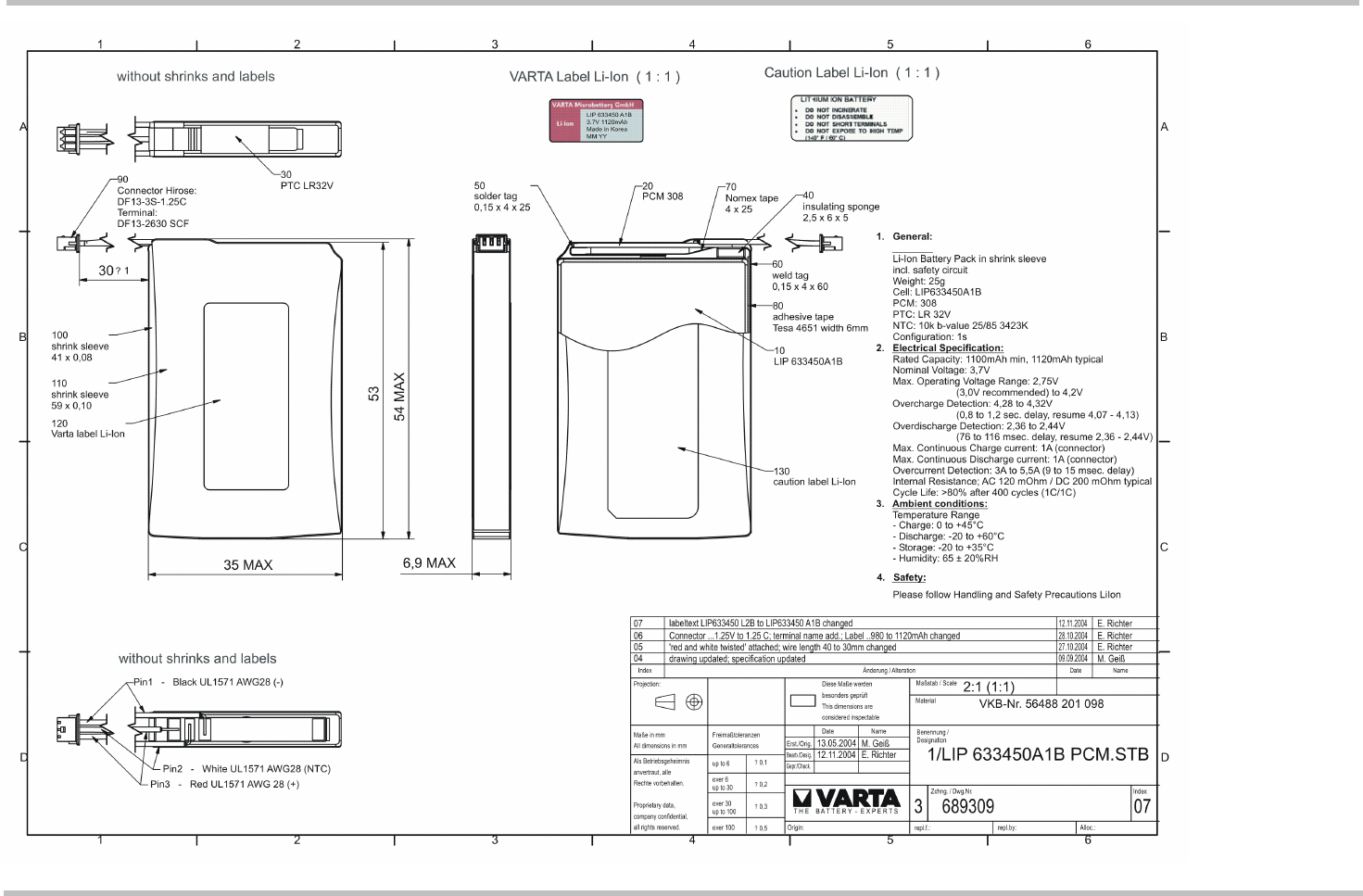
MC75 Hardware Interface Description
Strictly confidential / Draft s
MC75_V00.190a Page 90 of 91 15.02.2005
Figure 41: Lithium
Ion battery from
VARTA
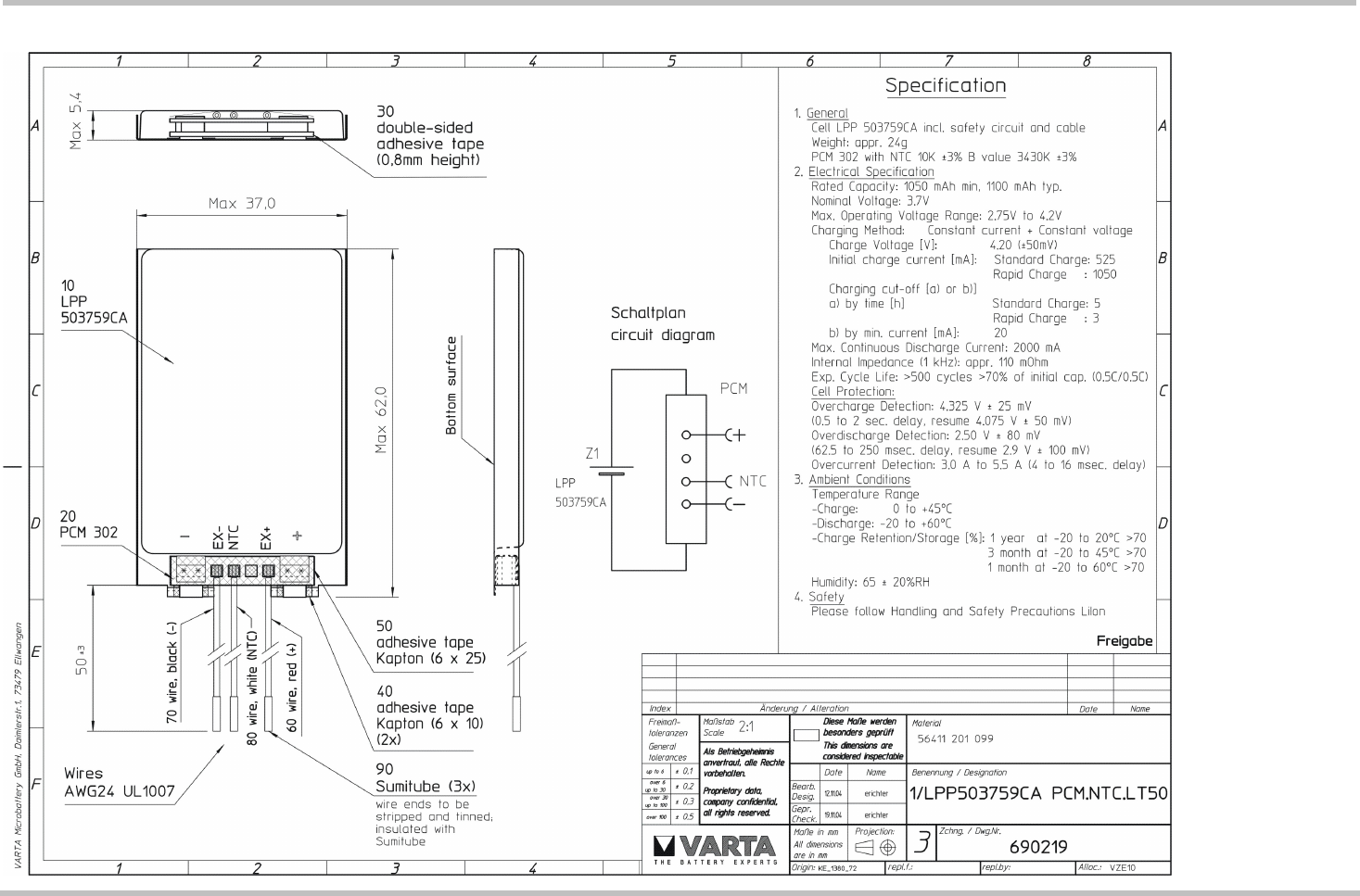
MC75 Hardware Interface Description
Strictly confidential / Draft s
MC75_V00.190a Page 91 of 91 15.02.2005
Figure 42: Lithium
Polymer battery
from VARTA